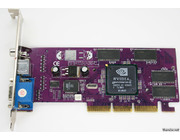An engineering sample of the GeForce 4 MX460. It features nVidia's stock cooler and is fully equipped with D-SUB, DVI and TV port. The MX460 is the fastest GeForce 4 MX of the breed. Could also get the MX 420 and 440 in 2002. Later models like the MX4000 and PCX4300 followed in 2003 and 2004 with the latter being a PCI Express card.
The GeForce 4 MX was launched in February 2002 along with various GeForce 4 Ti models. Both the MX and Ti are part of the GeForce 4 line-up, however, the GeForce 4 MX was basically an evolution of the GeForce 2 MX. It did have improvements various techniques to save on memory bandwidth and dual-monitor support but it lacked on vertex and pixel shaders which caused the card to be DirectX 7 compliant only. The GeForce 4 Ti is DirectX 8 compliant.
Unfortunately my card doesn't work properly due bad RAM. I wasn't able to benchmark it or to dump it's BIOS reliably.
The chip on my card is dated 48th week of 2001 which is a good 3 months before it's launch date. Also note that the chip says NV17 Pro, something that is also visible in the BIOS string. > Read more
This model has an AGP 8x interface which doesn't really improve performance but is just newer technology.
The GeForce 4 MX is the budget GeForce 4 variant. It is nowhere as fast as a GeForce 4 Ti which has all the features and performance. In terms of performance the GeForce 4 MX is a bit faster than the GeForce 2 Ti or Ultra but it cannot compete with the GeForce 3. The MX is rather an advanced GeForce 2 than a stripped GeForce 4 Ti.
Despite the fact that performance and features aren't impressive, the GeForce 4 MX sold in large quantities. > Read more
nVidia released the GeForce 4 MX as budget card. Practically it's nowhere near the GeForce 4 Ti but closer to the GeForce 2.
This card is the MX440-SE model which is slower. SE doesn't mean 'Special Edition' which lot's of people thought back in the time. The SE-model is an AGP-8x chip with a narrow memory bus (64-bit) which affects performance quite badly. > Read more






